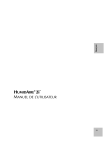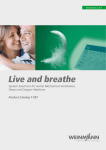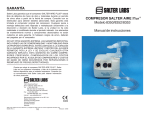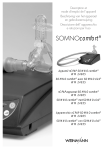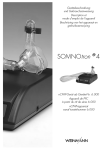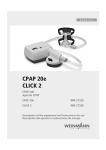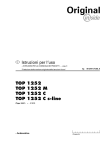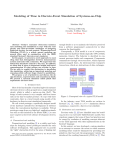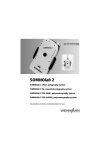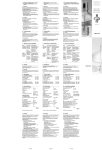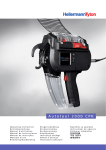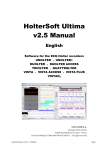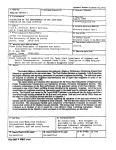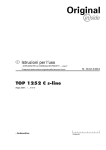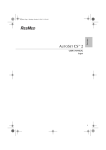Download SOMNOsmart 2 - Frank`s Hospital Workshop
Transcript
Servicing and repair instructions SOMNOsmart 2 smart PAP-device WM 24900 SOMNOsmart 2 with SOMNOclick WM 24950 SOMNOsmart 2 with SOMNOclick 300 WM 24975 SOMNOset Titration Device WM 23200 SOMNOset with SOMNOsupport WM 23210 SOMNOsoft + CPAP device with softPAP exhalation relief and therapy monitoring WM 24600 SOMNOsoft + with SOMNOclick WM 24610 SOMNOsoft + with SOMNOclick 300 WM 24675 Contents Introduction . . . . . . . . . . . . . . . . . . . . . . . . . 3 6. Troubleshooting . . . . . . . . . . . . . . . . . . . . . 20 1. Overview . . . . . . . . . . . . . . . . . . . . . . . . . . . 4 7. Repair Information and Instructions . . . . . . . 22 7.1 General . . . . . . . . . . . . . . . . . . . . . .22 7.2 Opening the device . . . . . . . . . . . . . .23 7.3 Closing the device . . . . . . . . . . . . . . .24 7.4 Replace Displayboard . . . . . . . . . . . .25 7.5 Replacing the fascia film . . . . . . . . . . .26 7.6 Changing fuses on the Powerboard . . .26 7.7 Replacing the Powerboard . . . . . . . . .27 7.8 Replacing the Smartboard/Softboard . .30 7.9 Replacing battery on Smartboard or Softboard. . . . . . . . . . . . . . . . . . . . .31 7.10 Replacing transformer . . . . . . . . . . . . .31 7.11 Replacing the oscillation generator (SOMNOsmart 2 and SOMNOset only) .34 7.12 Replacing the microphone (SOMNOsmart 2 and SOMNOset only) .35 7.13 Replacing Smartbox/Comfortbox . . . . .35 7.14 Replacing the fan. . . . . . . . . . . . . . . .36 7.15 Replacing lower part of housing . . . . . .41 7.16 Replacing upper part of housing . . . . . .42 2. Description . . . . . . . . . . . . . . . . . . . . . . . . . . 6 2.1 Purpose of SOMNOsmart 2 . . . . . . . . . 6 2.2 Purpose of SOMNOset . . . . . . . . . . . . 6 2.3 Uses SOMNOsoft + . . . . . . . . . . . . . . . 7 2.4 Function of SOMNOsmart 2 . . . . . . . . . 7 2.5 Function of SOMNOset . . . . . . . . . . . . 8 2.6 Functional description of SOMNOsoft + . . 9 3. Servicing . . . . . . . . . . . . . . . . . . . . . . . . . . 10 3.1 Intervals . . . . . . . . . . . . . . . . . . . . . . 10 3.2 Filter change . . . . . . . . . . . . . . . . . . . 10 – Coarse dust filter – Fine filter 3.3 Cleaning the device . . . . . . . . . . . . . . 11 3.4 Resetting the service symbol . . . . . . . . . 12 3.5 Disposal . . . . . . . . . . . . . . . . . . . . . 12 4. Hygienic preparation . . . . . . . . . . . . . . . . . 13 4.1 Cleaning and disinfecting after use . . . . 13 4.2 Cleaning and disinfection after repair . . 13 4.3 Cleaning and disinfecting on change of patient . . . . . . . . . . . . . . . . . . . . . . . 13 4.4 Cleaning and disinfecting the SOMNOclick/SOMNOclick 300 after use. . . . . . . . . . . . . . . . . . . . . .14 4.5 Cleaning and disinfecting the SOMNOclick/SOMNOclick 300 on change of patient . . . . . . . . . . . . . . .14 5. Test the device . . . . . . . . . . . . . . . . . . . . . . 15 5.1 General . . . . . . . . . . . . . . . . . . . . . .15 5.2 Performing the check . . . . . . . . . . . . .15 – Checking the power cord – Checking the housing – Checking display – Checking pressure and button functions – Checking OP signal (SOMNOsmart 2 and SOMNOset) – Checking function of humidifier 8. Tools, testing equipment and disinfectants . . 44 8.1 Tools . . . . . . . . . . . . . . . . . . . . . . . .44 8.2 Testing equipment and fixtures . . . . . . .44 8.3 Disinfectant. . . . . . . . . . . . . . . . . . . .45 9. Spare parts . . . . . . . . . . . . . . . . . . . . . . . . 46 9.1 Spare parts list . . . . . . . . . . . . . . . . .46 9.2 Spare parts required for servicing . . . . .48 10. Technical data . . . . . . . . . . . . . . . . . . . . . . 50 10.1 Specifications . . . . . . . . . . . . . . . . .50 10.2 Pressure-Volume curve. . . . . . . . . . . . .51 10.3 Safety distances . . . . . . . . . . . . . . . .52 11. Repair and service record . . . . . . . . . . . . . . 53 © Copyright Weinmann GmbH & Co. KG. The content and presentation are copyright protected and may only be used by authorised Weinmann Service Partners in the course of their service operations. The content must not be reproduced or passed on to third parties. The complete documents must be returned on termination of the cooperation with Weinmann. 2 Introduction For decades Weinmann has been developing, manufacturing and marketing devices for sleep apnoea therapy, inhalation therapy, oxygen therapy and emergency medical care. With its SOMNOcomfort and SOMNOvent S and ST, and also SOMNOsmart 2, SOMNOset and SOMNOsoft +, Weinmann offers a graduated therapy concept from treatment of sleep-related respiratory disorders to treatment of global respiratory insufficiency. The aim of these service and repair instructions is to familiarize you, as a trained expert in the field, with the function, technology, servicing and repair of the SOMNOsmart 2, SOMNOset and SOMNOsoft +. This will enable you to give your customers proper instructions, eliminate faults yourself, perform the tests specified in the operating instructions, carry out any repairs and service the device in accordance with these service and repair instructions. In the event of a guarantee claim, the devices must be sent to Weinmann. To enable us to process ex gratia requests or warranty claims, please enclose the customer’s proof of purchase (invoice) with the device. Repairs or servicing work may be performed only by Weinmann or by trained specialist staff. You are responsible for repairs carried out yourself and for their warranty! Use only original Weinmann spare parts for repairs. Please bear in mind: Your customer trusts you and relies on your expert capability, just as you rely on Weinmann. Note: For the following information, please consult the Operating Instructions for the individual devices: • Safety instructions • Preparing for use • Operation • Cleaning and disinfecting after use • Guarantee Introduction 3 1. Overview SOMNOsmart 2, SOMNOset and SOMNOsoft + 9 Drying adapter 15 Cap 2 Bacteria filter 3 Power cord 14 Mask 8 Stopper (2x) 13 Exhalation system 1 Therapy device 7 Device outlet port 10 Adapter 12 Hose system 11 Pressure measurement tube 6 Humidifier connection 5 Control panel and display 4 Ports Control panel and display SOMNOsmart 2 17 Total therapy time / Daily therapy time 16 Softstart symbol 22 Humidifier activated 23 Service symbol 18 Change filters 19 Pressure rise/Pressure drop and softPAP mode 28 Humidifier activated indicator 20 Therapy pressure lamp 21 LC display 24 On/Off button 26 Softstart button 27 Humidifier button (Levels 1-6) Control panel and display SOMNOset 17 Total therapy time / Daily therapy time 16 Softstart symbol 18 Change filters Pini Pini 24 On/Off button 22 Humidifier activated 23 Service symbol 25 Set button 19 Pressure rise/ Pressure drop 20 Therapy pressure 21 LC display 28 Humidifier indicator lamp 26 Softstart button 27 Humidifier button (Levels 1-6) Control panel and display SOMNOsoft + 16 Softstart symbol 17 Total therapy time / Daily therapy time 18 Change filters SOMNOsoft + 1 hPa 22 Humidifier activated 23 Service symbol 4 Overview 1 cmH2O 24 On/Off button 19 softPAP mode activated 20 Therapy pressure 21 LC display 27 Humidifier button 26 Softstart button 28 Humidifier (Levels 1-6) indicator lamp Device combinations 29 Filter cover IN LER WAND DC-AC INVERTER DC-AC OUT 31 Rating plate 32 Carrying bag 33 Power inverter 34 O2 switching valve 35 SOMNOclick/ SOMNOclick 300 30 Power connection Overview 5 2. Description Note: SOMNOsmart 2, SOMNOset and SOMNOsoft + are of largely identical basic design. They differ only in the software, display and fascia film. SOMNOsoft + has no oscillation generator and no microphone. 2.1 Purpose of SOMNOsmart 2 SOMNOsmart 2 is a smartPAP device for treating sleep-related respiratory disorders. SOMNOsmart 2 from software version 6.0; in general from device no. 10,000: The softPAP mode in- SOMNOsmart 2 generates positive airway pressure (PAP). creases patient comfort by means of a brief pressure reduction during the transition from inhalation to exhalation. SOMNOsmart 2 is a self-regulating device. It recognizes respiratory events and varies the airway pressure accordingly. While the patient is asleep, the airways are braced by the air pressure generated. Airway pressure is administered by means of a mask. SOMNOsmart 2 can be used for people aged 12 years or more. Important! SOMNOsmart 2 can reliably prevent closure of the airways only if the upper and lower pressure limits specific to the patient and prescribed by a doctor have been determined, e.g. in a sleep laboratory, and set accordingly. SOMNOsmart 2 is not suitable for use as a lifesupport system. 2.2 Purpose of SOMNOset SOMNOset is a device for efficient adjustment to CPAP patients. The device can work on a standalone basis or in conjunction with the remote control SOMNOadjust or an extended user interface of the SOMNOsupport software. The recorded data can also be visualized and evaluated with the aid of SOMNOsupport. Airway pressure is administered by means of a mask. SOMNOset permits titration without the patient coming to a sleep laboratory. Titration can be carried out in the patient's familiar surroundings. From the data recorded, the physician can determine the required therapy pressure. This pressure is set on the therapy device which is given to the patient for long-term therapy following titration. SOMNOset generates positive airway pressure (PAP). SOMNOset may be operated as a self-regulating device. In that case SOMNOset recognizes respiratory events and varies the airway pressure accordingly. While the patient is asleep, the airways are braced by the air pressure generated. 6 Description In the Autotitration mode the device determines, during the titration night, a therapy pressure (recommended titration pressure) that largely prevents closure of the upper airways. SOMNOset can be used for people aged 12 years or more. Important! SOMNOset is not suitable for use as a life-support system. 2.3 Uses SOMNOsoft + SOMNOsoft + is a CPAP device for treating sleeprelated respiratory disorders. Airway pressure is administered by means of a mask. SOMNOsoft + generates positive airway pressure (PAP). SOMNOsoft + can be used both in CPAP mode and in softPAP mode for individuals aged 12 years or more. The softPAP mode increases patient comfort by means of a brief pressure reduction during the transition from inhalation to exhalation. SOMNOsoft + recognises respiratory events. This permits efficient therapy control. During sleeping, the patient’s airways are braced by the air pressure generated. Important! SOMNOsoft + can reliably prevent closure of the airways only if the therapy pressure specific to the patient and prescribed by a physician has been determined, e.g. in a sleep laboratory. SOMNOsoft + is not suitable for use as a life-support system. 2.4 Function of SOMNOsmart 2 SOMNOsmart 2 works on the principle of an electrically powered flow generator delivering an electronically controlled constant pressure level. The exhalation system before the mask prevents accumulation of CO2-enriched expired air in the hose system. A radial fan draws in ambient air through a filter and conveys it to the device outlet port. From here the air flows through the hose system and the mask to the patient. Auto switch-on can be activated on the SOMNOsmart 2. The device can then be switched on by breathing into the mask. If there is no pressure for about 5 seconds (e.g. because the mask is taken off), the SOMNOsmart 2 switches off automatically. An oscillation generator creates a slight sinusoidal pneumatic oscillation in the air flow produced by the device. The airway and oscillation pressure is registered via the pressure measurement tube in the mask. The current oscillation pressure reading is compared with an average value and the preceding values. This evaluation of the oscillation pressure makes it possible to identify any significant change in airway resistance and hence to increase or reduce the therapy pressure via the flow generator. The pressure present in the mask is shown in the LC display. The microprocessor-controlled flow generator regulates the pressure at the value determined. The device also records a respiratory flow signal that can be output to a PSG system or read off with the aid of SOMNOsupport. This makes it possible to identify apnoea, hypopnoea and respiratory flow limitations. Following a power failure and resumption of the power supply, the status of SOMNOsmart 2 is the same as it was before the power failure. The stored data remain preserved. There are two functions designed to make it easier to go to sleep: (soft-)start or start pressure function. (Soft-)start function: When this is switched on, the pressure is adjusted to the (soft-)start pressure set by the physician. The pressure limits then gradually increase to the set values. The time taken for this increase is adjustable. This function is suitable for patients who find the high pressure unpleasant while they are awake. Additional function from software version 6.0: Start pressure function: The pressure remains at the set value throughout the start period. At the end of the start period, the pressure is reduced to the lower pressure limit. This function is suitable for patients who find low pressure unpleasant while they are awake, or who need high pressure quickly after they have gone to sleep. Description 7 In softPAP mode the respiratory flow curve is analysed continuously to ensure timely recognition of the transition between inhalation and exhalation. Before the transition to exhalation the therapy pressure is reduced to make it easier to breathe out. The size of this pressure reduction can be set in two stages: “slight” (stage 1) and “normal” (stage 2). This increases patient comfort. Before the next inhalation phase, the pressure is raised to the therapy figure once again. If apnoea or valid flow limitations occur while the patient is sleeping, the softPAP mode is automatically deactivated for the relevant period. If the respiratory frequency is too high, the softPAP mode is also temporarily deactivated. However, the therapy pressure remains reduced during this period. In full face mode the device supports therapy with a full face mask. The event-related pressure adjustment is modified accordingly. 2.5 Function of SOMNOset SOMNOset works on the principle of an electrically powered flow generator delivering an electronically controlled constant pressure level. the aid of SOMNOsupport. This makes it possible to identify apnoea, hypopnoea and respiratory flow limitations. A radial fan draws in ambient air through a filter and conveys it to the device outlet port. From here the air flows through the hose system and the mask to the patient. The exhalation system before the mask prevents accumulation of CO2-enriched expired air in the hose system. An oscillation generator creates a slight sinusoidal pneumatic oscillation in the air flow produced by the device. The airway and oscillation pressure is registered via the pressure measurement tube in the hose system. The current oscillation pressure reading is compared with an average value and the preceding values. This evaluation of the oscillation pressure makes it possible to identify any significant change in airway resistance and hence to increase or reduce the therapy pressure via the flow generator. The pressure present in the mask is shown in the LC display. The microprocessor-controlled flow generator regulates the pressure at the value determined. The values determined are recorded. In Autotitration mode, the recommended therapy pressure is calculated at the end of the titration night. The device also records a respiratory flow signal that can be output to a PSG system or read off with 8 Description To make it easier for the patient to go to sleep, an automatic Softstart system is incorporated for the APAP and CPAP modes. When this is switched on, the pressure is reduced to the Softstart pressure set by the physician. The therapy pressure then gradually increases to the set value. The period for the pressure rise can be set in 5-minute steps between 0 and 30 minutes. The automatic Softstart system can be locked out by the physician. Auto switch-on can be activated in APAP and CPAP modes. The device can then be switched on by breathing into the mask. If there is no pressure for about 5 seconds (e.g. because the mask is taken off), the SOMNOset switches off automatically. If the power supply is interrupted and then restored, data recording starts afresh in all modes. In that case, pressure adjustment and event evaluation restart in the Autotitration and APAP modes. In the Pressure Profile and CPAP modes, titration or therapy are continued in the status that was active before the interruption. The stored data remain recorded despite the interruption. 2.6 Functional description of SOMNOsoft + SOMNOsoft + works on the principle of an electrically powered flow generator delivering an electronically controlled constant pressure level. A radial fan draws in ambient air through a filter and conveys it to the device outlet port. From here the air flows through the hose system and mask to the patient. The airway pressure is registered via the pressure measurement tube in the mask. The pressure present in the mask is shown in the LC display. The microprocessor-controlled flow generator regulates the pressure at the set value. In softPAP mode the respiratory flow curve is analysed continuously to ensure timely recognition of the transition between inhalation and exhalation. Before the transition to exhalation the therapy pressure is reduced to make it easier to breathe out. The size of this pressure reduction can be set in two stages: “slight” (stage 1) and “normal” (stage 2). This increases patient comfort. Before the next inhalation phase, the pressure is raised to the therapy figure once again. If apnoea or valid flow limitations occur while the patient is sleeping, the softPAP mode is automatically deactivated for the relevant period. If the respiratory frequency is too high, the softPAP mode is also temporarily deactivated. However, the therapy pressure remains reduced during this period. The device also records a respiratory flow signal that can be output to a PSG system or read off with the aid of SOMNOsupport. SOMNOsoft + recognises apnoea, hypopnoea and respiratory flow limitations. This permits efficient therapy control. The exhalation system in front of the mask prevents accumulation of CO2-enriched expired air in the tube system. An automatic Softstart system is provided to enable the patient to go to sleep more easily. When this is switched on, the pressure is reduced to the Softstart pressure set by the physician. The therapy pressure then gradually increases to the set value. The period for the pressure rise can be set in 5minute steps between 0 and 30 minutes. The automatic Softstart system can be locked out by the physician. Auto switch-on can be activated on the SOMNOsoft + The device can then be switched on by breathing into the mask. If there is no pressure for about 5 seconds (e.g. because the mask is taken off), SOMNOsoft + switches off automatically. Following a power failure and resumption of the power supply, the status of SOMNOsoft + is the same as it was before the power failure. The stored data remain preserved. Description 9 3. Servicing 3.1 Intervals The two filters 45 and 46 need to be checked regularly for soiling. • Coarse dust filter 45 must be changed every 6 months. • Fine filter 46 must be changed at least every 250 operating hours. • The pressure measurement tube 11 must be changed at least every 6 months – and more frequently if soiling is heavy. For hygiene reasons we recommend: • replacing the complete mask system every 6 to 12 months depending on soiling, and • replacing the expiration system in accordance with the relevant operating instructions. See the section on “Cleaning” in the relevant operating instructions. The following preventive maintenance measures must also be carried out: 1. Service after every 5000 operating hours (service symbol 23 appears in display and must be reset after every service). 2. Service after a maximum of 2 years (see service label on back of device). 3. The parts exposed to the air flow must be cleaned every 10,000 hours or 4 years. 4. Every 2 years the battery on the Smartboard or Softboard must be replaced. After every service, replace the service label 87 with one bearing the new data (see “9. Spare parts” on page 46). Use a hole punch or nail scissors (V-shaped notch) to mark the month. Affix the new service label to the left of the filter cover. 87 3.2 Filter change 3.2.1 Coarse dust filter 1. To ensure that no water runs into the device 1 when changing the filters, disconnect the humidifier 35 from the device. Also observe the operating instructions supplied. 2. Slightly raise the rear of the device or push the back of the device off the edge of the table a little, so that you can reach under the filter cover 29. 10 Servicing 3. Press with your thumb on the underside of the filter cover 29 and lift the cover off. 4. Pull out the coarse dust filter 45 with your finger. 5. You can wash a soiled coarse dust filter in clean water and reuse it after drying thoroughly. 29 6. Insert the clean coarse dust filter 45. 7. Insert the filter cover 29 in the opening in the housing with its upper edge first. 8. Using a finger to press in the catch on the underside of the cover, fit the cover so that it clicks into place. 9. If appropriate, fit the humidifier. Observe the section “3.4 Humidifier” in the operating instructions. 45 3.2.2 Fine filter 1. Remove the coarse dust filter 45 as described under “3.2.1 Coarse dust filter”. 2. Remove the fine filter 46. The fine filter must be changed if it has turned dark grey, and in any case after 250 operating hours. In the latter case the filter change symbol appears. 3. Insert the new filter and filter cover 29 in reverse order. 4. To clear the filter change symbol, hold down the on/off button 24 when switching on the device until the symbol disappears from the display. 46 45 If the fine filter is changed because of soiling before 250 operating hours are reached, the hour counter must be reset to zero: 5. To do so, hold down the On/Off button 24 when switching on the device. After about 3 seconds the filter change symbol lights up and after another 3 seconds it disappears. Now you can release the button. 3.3 Cleaning the device The parts exposed to the air flow must be cleaned and disinfected every 10,000 hours or every 4 years. This must be done as described in Chapter “4.3 Cleaning and disinfecting on change of patient” on page 13. After every service a test must be performed in accordance with Chapter “5. Test the device” on page 15. Servicing 11 3.4 Resetting the service symbol After every service/repair the service hours counter must be reset to “0”, and the service symbol 23 in the display must be cleared. A new service label (current year + 2 years) must also be affixed to the back of the device. 1. To reset the service hours counter to “0” or to switch off the service symbol, hold down the Softstart button 26 with the device switched off until A0/A1 or soft0/soft1/soft2 appears in the display. 24 23 2. Now press the On/Off button 24 as well until an S (for “service key”) appears. 26 3. Now release both buttons. 4. Briefly pressing the On/Off button 24 clears the service key. If you want set the service symbol again, press the On/Off button 24 again. Pini 23 26 25 24 SOMNOsoft + 23 1 hPa 1 cmH2O 26 3.5 Disposal Do not dispose of the device with domestic waste. To dispose of the device properly, please contact a licensed, certified electronic scrap disposal merchant. This address is available from your Environment Officer or from your local authority. 12 Servicing 24 4. Hygienic preparation 4.1 Cleaning and disinfecting after use Caution! This point is described in Chapter 5 “Cleaning and Disinfection” of the SOMNOsmart 2, SOMNOset or SOMNOsoft + operating instructions. Hygienic preparation of the device after repairs and for a new patient is described below. 4.2 Cleaning and disinfection after repair In the event of repairs the following work should be performed by the qualified dealer. Caution! Be sure to follow the disinfectant manufacturer’s instructions (8.3, page 45). You are recommended to wear suitable gloves (e.g. household or disposable gloves) during disinfection procedures. • Wipe outside of device and power cord with TERRALIN disinfectant. • Clean hoses, cap and mask as described in the operating instructions or replace with new parts (depending on condition). • Open device as described in 7.2. • Replace the coarse dust filter and fine filter 45 + 46 as described in Chapter 3.2. • Clean the inside of the device and filter housing with a vacuum cleaner. Thoroughly clean any specially dirty parts. • Close device as described in 7.3. 4.3 Cleaning and disinfecting on change of patient When making the device hygienic for a new patient, the following steps must be carried out: Caution! Be sure to follow the disinfectant manufacturer’s instructions (8.3, page 45). You are recommended to wear suitable gloves (e.g. household or disposable gloves) during disinfection procedures. • • Replace the coarse dust filter and fine filter 45 + 46 as described in Chapter 3.2. • Spray-disinfect device outlet 7, filter holder 44 and filter cover 29 twice with “MIKROZID LIQUID”, taking care to wait for the prescribed disinfection time in each case. At the beginning of the disinfection time, also wipe the accessible surfaces with a cloth moistened with “MICROZID LIQUID”. Wipe outside of device and power cord with TERRALIN disinfectant. Dispose of hose and mask system and carrying bag, and replace with new parts. • Open device as described in Chapter 7.2. • Clean the inside of the device and filter housing with a vacuum cleaner. Thoroughly clean any specially dirty parts. Caution! No disinfectant residues must be left in the pressure measurement stub of the device outlet port 7; if necessary the pressure measurement stub must be blown dry. • Replace OPS delivery tube 61 (only SOMNOsmart 2 and SOMNOset). Hygienic preparation 13 • Open box 62/63 as described in Chapter 7.14. • Close box 62/63 again as described in Chapter 7.14. • Replace both labyrinths 64 and 66, motor frame 65, box damper insert 69 and cover damper insert 68. Remove fan cap from fan. • Alternatively, box 62/63 can be replaced by an exchange box (see “7.13 Replacing Smartbox/Comfortbox” on page 35). • Spray-disinfect the box, fan and fan cap twice with “MIKROZID LIQUID”, taking care to wait for the prescribed disinfection time in each case. At the beginning of the disinfection time, also wipe the accessible surfaces with a cloth moistened with “MICROZID LIQUID”. • Close appliance as described in Chapter 7.3. Wipe housing and power cord with TERRALIN disinfectant. • Set service symbol and clear it again, to reset the service hours counter to “0” (see “3.4 Resetting the service symbol” on page 12). Spray-disinfect fan blade twice with “MIKROZID LIQUID”. The fan blades must not be exposed to any mechanical forces. • Test the device. • Use SOMNOsupport to clear the patient data stored in the device. Observe the relevant operating instructions. • • Dip-disinfect connecting tube 59 mit “GIGASEPT FF”. 4.4 Cleaning and disinfecting the SOMNOclick/SOMNOclick 300 after use This point is described in Chapter 4 “Cleaning and Disinfection” of the SOMNOclick or SOMNOclick 300 operating instructions. 4.5 Cleaning and disinfecting the SOMNOclick/SOMNOclick 300 on change of patient When making the device hygienic for a new patient, the following steps must be carried out: • 14 For hygiene reasons we recommend replacing the plastic parts after a maximum of 2 years’ use. The spare parts list can be found in the SOMNOclick/SOMNOclick 300 operating instructions (WM 16719). Hygienic preparation • If plastic parts and heating element are badly soiled or covered with lime scale, offer the customer a new device, otherwise: Proceed as described in Chapter “4. Hygienic preparation” of the SOMNOclick/ SOMNOclick 300 operating instructions (WM 16719). 5. Test the device 5.1 General Important A test is required after every service or repair. Please enter the following figures in your service record sheet (see Page 53): For SOMNOsmart 2: operating hours, humidifier level, Softstart time and Softstart initial pressure, and the patient’s pressure limits and pressure rise rate as shown in the patient pass. If the test reveals faults or deviations from the specified values, the device must not be used again until the faults are rectified. To find out what may be causing the faults and how to remedy the malfunction, see Chapter „6. Troubleshooting“ on page 20. For SOMNOset: operating hours, humidifier level, Softstart time and Softstart initial pressure, and the patient’s pressure limits and pressure rise rate as shown in the patient pass, and also the mode. For SOMNOsoft +: operating hours, humidifier level, Softstart time and Softstart initial pressure, CPAP pressure and mode. 5.2 Performing the check 5.2.1 Checking the power cord 1. Check the power cord 3. Make sure that – the insulation is sound, – the cable is undamaged, – there are no loose connections. 2. If necessary, change the power cord 3. 5.2.2 Checking the housing Check the general condition of the housing. – If the housing is damaged or faulty, replace the relevant side of the device (see „7.15 Replacing lower part of housing“ on page 41 or „7.16 Replacing upper part of housing“ on page 42). Test the device 15 5.2.3 Checking display 1. Check that the fascia film of the control panel 5 is flat all over and firmly in place. If it is not, replace the fascia film (see “7.5 Replacing the fascia film” on page 26). 2. Now fix up the power supply by connecting one end of the power cord 3 to the device and the other to the wall socket. 3. Press the On/Off button 24. The LC display 21 appears. 4. Briefly open and close the device outlet port. The LC display changes. 5 21 26 24 5. Switch off the device with button 24. The day’s therapy duration appears briefly in the LC display 21. Then only “0” is left showing on the LC display 21. 5.2.4 Checking pressure and button functions 1. Assemble the device ready for use with hose system 12, mask 14 and power cord 3 attached. Note: If the SOMNOset is in Autotitration or Pressure Profile mode, switch to APAP or CPAP. 2. With the device switched off, press the Softstart button 26 repeatedly until the current auto switch-on setting (A0 or A1) appears in the display. Note: 24 21 if the exhalation relief setting (soft0/soft1/ soft2) appears in the display, first press the humidifier button 27 to switch to the auto switch-on setting. 26 27 3. If necessary, press the On/Off button 24 to change the setting to A1. – The device will now be switched on automatically as soon as breathing through the mask starts (pressure > 0.5 hPa), – When the mask is removed, the device must switch off after 5 seconds. Pini 21 27 4. The day’s therapy duration appears briefly in the LC display 21. After that, only “0” is left showing on the LC display 21. 16 Test the device 25 1 hPa 21 27 24 24 SOMNOsoft + 5. Press the On/Off button 24 to switch the device on. For 3 seconds the display shows the total use time 17. 6. Close the opening of the mask, e.g. with your thumb or hand, and hold it closed. 26 1 cmH2O 26 7. If Softstart is switched on, switch it off by pressing button 26. The radial fan delivers air through the hose system to the mask, and the current pressure in hPa is shown in the LC display 21. 8. Compare the pressure shown in the LC display 21 with the prescribed minimum pressure limit. After approx. 1 minute the difference must be not more than ± 0.2 hPa. 9. Use a pressure gauge to check the set pressure at the connection stub of the mask. – To do so, remove one stopper. Stopper – Connect a pressure gauge to the open connection stub. Compare the reading with the figure shown on the LC display 21. After approx. 1 minute the difference must be not more than ± 0.4 hPa. 10. Press button 26 to switch on Softstart. The Softstart symbol 16 appears and the LC display 21 shows the Softstart time. At the same time the pressure is reduced to the initial Softstart pressure. 24 16 21 26 The Softstart function can be locked out by the physician. In that case the Softstart initial pressure shown in the display is “– –”. 16 Pini 21 16 26 24 24 SOMNOsoft + 1 hPa 21 1 cmH2O 26 Test the device 17 5.2.5 Checking OP signal (SOMNOsmart 2 and SOMNOset) Measuring equipment required: • ESD workplace, • Multimeter, • PSG connecting cable, WM 23976, • Operating instructions for PSG connecting cable, WM 16250. Important Auto switch-on must be deactivated. 1. Use SOMNOsupport to assign the OP signal to channel 1. 2. Insert the Western plug W of the PSG connecting cable in port 4 of the device. 3. Connect the pair of wires marked O to the multimeter. The insulated wire 6 is the plus pole for the oscilatory pressure (OP), the bare wires 5 are the earth. 4. Select a suitable measuring range on the multimeter, e.g. 0 – 2 V DC. 5. Switch on the device at the On/Off switch 24. 6. With the mask open, the voltage measured must be ≤ 0.3 V DC. With the mask closed (use your hand to hold it closed), the voltage measured must be ≥ 0.4 V DC. If no OP signal can be measured, remove the battery from the device (see “7.9 Replacing battery on Smartboard or Softboard” on page 31) for a few minutes, then put it back. Perform the measurement again. If there is still no measurable OPS, the Smartboard must be replaced. 7. Switch off the device at the On/Off switch 24. 18 Test the device 5 1 5 W T 6 O 5.2.6 Checking function of humidifier 1. Make a visual inspection of the plastic housing: If there are any cracks/damage or heavy soiling, the plastic parts or seals must be replaced. 2. Fill the humidifier up to the mark with water. 3. Check that the humidifier is not leaking. 4. Pour the water out. 5. Now pour in 50 ml water. 6. Click-fit the humidifier to the therapy device. 7. Insert the red drying adapter (supplied with the therapy unit) in the outlet connection stub of the humidifier. 8. Push the hose system onto the drying adapter. 9. Switch on the therapy appliance. 10. Switch on the humidifier by pressing the Humidifier button on the therapy device. 11. Select heating level 6 on the therapy device. 12. Check that the humidifier is heating up. 13. Remove the hose system by pressing the adapter release catch. 14. Remove the red drying adapter from the humidifier by twisting it slightly. If servicing was completed successfully, reset the service symbol (see “3.4 Resetting the service symbol” on page 12). Test the device 19 6. Troubleshooting Fault Cause No running noise, ”Standby” and ”Operating” indicators do not come on. No power supply. Check connection between power cord and device or socket. Check power supply with a different device (e.g. lamp). If necessary, replace power cord. Fuse has blown. Replace fuse (Chapter 7.6, page 26). Transformer defective. Replace transformer (Chapter 7.10, page 31). Display board defective Replace displayboard (Chapter 7.4, page 25). Smartboard or Softboard Replace Smartboard or Softboard (Chapter 7.8, page 30). faulty. Powerboard defective. No running noise after ”Operating” indicator comes on. Rectifying faults Motor not turning. Replace Powerboard (Chapter 7.7, page 27). Send defective Powerboard to manufacturer for fault analysis. Replace Powerboard (Chapter 7.7, page 27). Send defective Powerboard to manufacturer for fault analysis. Replace fan (Chapter 7.14, page 36). Transformer defective. Replace transformer (Chapter 7.10, page 31). Fuse has blown. Replace fuse (Chapter 7.6, page 26). Faulty display or none at Display defective. all. Replace displayboard (Chapter 7.4, page 25). Tolerance of therapy Smartboard or Softboard pressure is >0.4 hPa after Replace Smartboard or Softboard (Chapter 7.8, page 30). faulty. 1 minute. Device cannot be switched on by breathing into mask in Automatic mode. Automatic mode not active. Activate auto switch-on (see 4.1. of operating instructions). SOMNOset only: Autotitration or Pressure Profile mode active. Auto switch-on is not available in these modes. (See “Supplementary Operating Instructions for Medical Staff SOMNOset”). Powerboard defective Replace Powerboard (Chapter 7.7, page 27). Smartboard or Softboard Replace Smartboard or Softboard (Chapter 7.8, page 30). faulty. Device runs, but does not Filters soiled. reach lower pressure Leak in mask. limit. Auto switch-on mode not Device does not switch activated off 5 seconds after mask SOMNOset only: is removed. Autotitration or Pressure Profile mode active. Filter change indicator comes on. Service symbol on comes Filters soiled. Change both filters (Chapter 3.2, page 10). Adjust cap and/or headstraps so that mask is a firm fit. Activate auto switch-on (see section 4.1 of operating instructions). Auto switch-on is not available in these modes. (See “Supplementary Operating Instructions for Medical Staff SOMNOset”). Clean or change both filters (Chapter 3.2, page 10). Have device serviced as soon as possible by Weinmann or an authorized dealer. Battery on Smartboard/ Softboard run down, Replace battery on Smartboard/Softboard (Chapter 7.9, Internal clock data not page 31) and reset date/time. Error message “Err b” in plausible display Internal clock data not Replace Smartboard/Softboard (Chapter 7.8, page 30) and plausible reset date/time. 20 Troubleshooting Data stored in E2Prom incorrect (e.g. Error message “Err d” in Replace Smartboard or Softboard (Chapter 7.8, page 30) and compliance counter, display reset date/time. operating hours counter), therapy data are correct Check microphone, replace if necessary. Error message “Err P” in display Oscillation pump defective Replace oscillation pump. Replace Smartboard or Softboard (Chapter 7.8, page 30). Error message “Err c” in display Pressure sensor not calibrated or incorrectly calibrated Replace Smartboard or Softboard (Chapter 7.8, page 30). Check fuses and replace if necessary (Chapter 7.6, page 26). Replace Powerboard (Chapter 7.7, page 27). Error message “Err S” in Fan not running display Replace Smartboard or Softboard (Chapter 7.8, page 30). Replace fan (Chapter 7.14, page 36). Check continuity of pressure measurement zone. Therapy data stored in Error message “Err E” in E2Prom (e.g. pressures, display pressure calibration) are incorrect Water in humidifier does not heat up. Replace Smartboard or Softboard (Chapter 7.8, page 30) and reset date/time. Humidifier defective. Test with different humidifier. If device defective, send humidifier to manufacturer. Powerboard defective. Replace Powerboard (Chapter 7.7, page 27). Send defective Powerboard to manufacturer for fault analysis. Power cord damaged Replace power cord. Ribbon cable for membrane keyboard has Check whether ribbon cable is correctly connected to Device will not switch on slipped out of Displayboard. via membrane keyboard connection. Fascia film defective Replace fascia film (Chapter 7.5, page 26). Troubleshooting 21 7. Repair Information and Instructions 7.1 General Always perform repairs to SOMNOsmart 2, SOMNOset and SOMNOsoft + at an ESD workplace. • Observe the safety information in the operating instructions for SOMNOsmart 2, SOMNOset and SOMNOsoft +. • All operations on this device require detailed knowledge and observation of the Operating Instructions and the Service and Repair Instructions. • Do not carry out any repairs that are not described in these Service and Repair Instructions. This is the only way to guarantee trouble-free functioning of SOMNOsmart 2, SOMNOset and SOMNOsoft +. • Make sure that your hands and workplace are clean during the repair work. • Be sure to carry out a test after every repair (see “5. Test the device” on page 15). • If you replace components or individual parts, use only genuine Weinmann parts. • When ordering the lower part of the housing 42, please specify device type, year of manufacture and device number. Note: The item numbers quoted in the following text are identical to the item numbers in the spare parts list on Page 46 and the overview on Page 4. Important! These service and repair instructions are for the devices SOMNOsmart 2, SOMNOset and SOMNOsoft +. In most cases the description is the same for all three devices. If this is not the case, the text draws attention to the fact. The illustrations usually show the maximum equipment level, with oscillation generator, microphone and the relevant cables. Please note that SOMNOsoft + does not have these components. Oscillation generator SOMNOsmart 2, SOMNOset SOMNOsoft + 22 Repair Information and Instructions 7.2 Opening the device Tools and equipment required: • Allen key 3 mm, • ESD workplace. Caution! Always pull out the mains plug before opening the device. 1. Place the device upside down on a non-slip surface. 2. Slacken and remove the 2 screws 40 and the 2 screws 41. 3. Hinge the lower part of the housing 42 away to the side. 40 42 41 48 4. Pull the Western port of the connecting cable 48 out of the housing base 42. 5. Disconnect plug X300 from the board. 6. Now you can put the lower part of the housing 42 on one side. X300 Caution! On older devices there is a second connecting cable: SOMNOsmart 2 up to device number 7256 SOMNOset up to device number 1112 SOMNOsoft + up to device number 1264 Second connecting cable 7. Remove the Western socket from the base of the device. Repair Information and Instructions 23 If the second connecting cable is damaged, proceed as follows: 1. Replace the connecting cable with connecting cable 49. Smartboard or Softboard Plug for Smartboard or Softboard 2. Replace the base of the device (see “7.15 Replacing lower part of housing” on page 41). 49 Plug for Powerboard (X1) red 7.3 Closing the device Tools and equipment required: • Allen key 3 mm, • ESD workplace. 1. Hold the lower part of the housing 42 against the upper part 43. 2. Push connector X300 onto the Powerboard 47. The lug on the connector must be facing the catch. 3. Push the Western port of the connecting cable 48 into the guides in the lower part of the housing 42. 48 42 51/52/53 47 4. Check that all tubes and cables are firmly connected. If necessary, push them carefully right onto the stubs (tubes) or auf die connection points (cables). 5. Align the Powerboard 47 and Smartboard 51/ 52 or Softboard 53 in the guides inside the device. 6. Place the lower part of the housing 42 on the upper part 43. Make sure that the Powerboard 47 is correctly fitted and that the connecting cable 48 is not trapped. 7. Now screw the upper part of the housing tight using the 2 screws 40 and 2 screws 41. 8. Finally, turn the device the right way up. 24 Repair Information and Instructions X300 43 40 41 7.4 Replace Displayboard Tools and equipment required: • Allen key 3 mm, • ESD workplace, • Phillips screwdriver size 1. 1. Open the device (see “7.2 Opening the device” on page 23). 2. Pull the connecting cable off the Smartboard/ Softboard. 3. Detach the ribbon cable for the fascia film: To do so, pull the catch upwards. Then you can lift out the ribbon cable. Connecting cable Caution: Ribbon cable If the catch is not opened correctly, the ribbon cable will be damaged when pulling it out. Catch 4. Slacken the two screws 55 slightly. 55 50 56 5. Remove the Displayboard 50 by pushing it upwards against the clamp plates 56, removing it at the bottom from the holder in the housing, and then lifting it out. 6. Insert a new Displayboard 50: First push the Displayboard under the clamp plates 56, then place it in the holder in the housing. 7. Align the clamp plates 56 and screw them tight with screws 55. 8. Reconnect the ribbon cable for the fascia film to the Displayboard. – Pull the catch upwards. – Push the ribbon cable into the connection. – Press the catch down again. 9. Push the connecting cable for the Displayboard onto the appropriate connector on the Smartboard/Softboard. Ribbon cable Connecting cable Catch 10. Close the device (see “7.3 Closing the device” on page 24). 11. Perform a test (see “5. Test the device” on page 15). Repair Information and Instructions 25 7.5 Replacing the fascia film Tools and equipment required: • Allen key 3 mm, • ESD workplace, • Phillips screwdriver size 1, • Knife with smooth, flat blade. 1. Open the device (see “7.2 Opening the device” on page 23). 2. Remove the Displayboard (see “7.4 Replace Displayboard” on page 25, steps 3. to 5.). 3. Detach fascia film with a knife blade and pull off carefully. Degrease this area of the housing with a little 70%-strength isopropanol. 4. Remove the protective film from the inside of the new fascia film and stick the fascia film 37/ 38/39 to the appropriate part of the housing. Take care when inserting the ribbon cable through the opening in the housing; it must be properly routed without any kinks. 5. Using your finger nail, carefully remove the outer protective flim from the new fascia film. 6. Fit the Displayboard (see “7.4 Replace Displayboard”, steps 6. to 8.). 7. Close the device (see “7.3 Closing the device” on page 24). 8. Perform a test (see “5. Test the device” on page 15). 7.6 Changing fuses on the Powerboard Tools and equipment required: • Allen key 3 mm, • ESD workplace. 1. Open the device (see “7.2 Opening the device” on page 23). 2. Carefully lift the Powerboard 47 and Smartboard 51/52 or Softboard 53 slightly. 26 Repair Information and Instructions Ribbon cable 3. Check whether one of the fuses F1 (88), F2 (89), F3 (89) or F4 (89) has blown. F3 (89) F4 (89) V IO SW GR BLGE Caution: Fuses 88 (F1) and 89 (F2, F3, F4) have RT 4. Remove the faulty fuse and replace it with a new one. Fuses F3 (89) and F4 (89) must always be changed at the same time. GN WS F2 (89) different current ratings! Take care to use the right rating. F1 (88) 5. Carefully press Powerboard 47 and Smartboard 51/52 or Softboard 53 back into the groove in the housing. 6. Close the device (see “7.3 Closing the device” on page 24). 7. Perform a test (see “5. Test the device” on page 15). 7.7 Replacing the Powerboard Tools and equipment required: • Allen key 3 mm • Philips screwdriver • ESD workplace. 1. Open the device (see “7.2 Opening the device” on page 23). 51/52/53 47 X4 X5 2. Pull the display plug off the Smartboard/ Softboard. Display connector 3. Does not apply to SOMNOsoft +: Detach plugs X5 and X4 from Smartboard 51/ 52. 4. Detach the pressure measurement tube 60 from the stub at the device outlet port. 60 5. Carefully lift Powerboard 47 and Smartboard 51/52 or Softboard 53 from inside the device. 6. Press the catch and remove the connector of the connecting cable 48 from the Powerboard. 48 49 Guide hole 47 7. Pull plugs X6, X5 and X4 off the power board 47. RT VIO SW 8. Carefully pull the three cables out through the guide hole in the Powerboard. GR GN WS BL GE Catch X4 X5 X6 Repair Information and Instructions 27 9. Undo the connector catch and carefully pull out plug X100. GR GN WS BL GE 12. Undo the other 3 screws 55. VIO SW X100 11. Loosen the screws 55 on the battery holder and remove the spring 57 and the sealing washer 58 from the Smartboard. RT 10. Remove the defective Powerboard 47 together with Smartboard 51/52 or Softboard 53 from the device. Catch 55 58 57 55 13. Carefully detach Smartboard 51/52 or Softboard 53 from the Powerboard. 51, 52 14. Disconnect plug X1 of the connecting cable 49 from the Powerboard. Smartboard/Softboard and Powerboard are now completely separated X2 X1 54 Caution: Make sure you do not confuse the two plugs for the connecting cable 49. Smartboard or Softboard Plug for Smartboard or Softboard 15. Unscrew the distance pieces 54 from the defective Powerboard. 16. Place plug X1 of the connecting cable 49 firmly on the new Powerboard. 49 Plug for Powerboard (X1) red 17. Carefully place Smartboard 51/52 or Softboard 53 on the new Powerboard so that plug X2 of the Powerboard fits into the corresponding coupling on the Smartboard (see double arrow in diagram). 18. Place the spring 57 and the sealing washer 58 on the battery holder on the Smartboard/ Softboard and fix the two parts with a screw 55. 19. Fasten the Smartboard 51/52 or Softboard 53 to the Powerboard with the remaining 3 screws 55. 20. Now insert the Powerboard 47 together with the Smartboard/Softboard in the device as described in the following steps. 28 Repair Information and Instructions RT 21. Run the cable of plug X100 under the Powerboard 47 and insert the plug in the appropriate connection. VIO SW GR GN WS BL GE X100 22. Push plug of connecting cable 48 onto the Powerboard. 48 47 Catch Guide hole 23. Carefully thread the three cable harnesses for X4, X5 and X6 into the guide hole of the Powerboard. RT VIO SW 24. Connect the transformer plugs X4, X5 and X6 to the Powerboard. GR GN WS BL GE Caution! Do not under any circumstances confuse plugs X4 and X5. The plugs can be distinguished by the colours of the wires: Catch X4: black and grey wires (“SW” + “GR”), X5: violet and red wires (“VIO” + “RT”). X4 X5 X6 The colours are likewise indicated as abbreviations on the Powerboard. 25. Carefully insert the boards into the upper part of the housing again. When doing so, run the connecting cables 48 and 49 along under the Smartboard/Softboard. Caution! Make sure that no cables are jammed between the housing and the boards. 26. Fit the pressure measurement tube 60 onto the stub at the device outlet port. 47 X4 X5 27. Connect the display connector to the Smartboard/Softboard. 28. Does not apply to SOMNOsoft +: Attach the plug of the microphone cable X5 (marked on the board as “MIC”) and the plug of the oscillation generator cable X4 (marked on the board as “OGEN”), and also the display connector to the Smartboard. Display connector 60 29. Close the device (see “7.3 Closing the device” on page 24). 30. Perform a test (see “5. Test the device” on page 15). Repair Information and Instructions 29 7.8 Replacing the Smartboard/Softboard Tools and equipment required: • ESD workplace, • Allen key 3 mm, • Phillips screwdriver size 1. 1. Open the device (see “7.2 Opening the device” on page 23). 2. Carefully remove the Powerboard 47 (see “7.7 Replacing the Powerboard” on page 27, steps 5. to 14.). 3. Disconnect the plug of the connecting cable 49 from the Powerboard. Smartboard/ Softboard and Powerboard are now completely separated. 55 58 57 55 51, 52 Caution: Make sure you do not confuse the two plugs for the connecting cable 49. X2 Plug for Smartboard or Softboard 5. Connect the plug of connecting cable 49 firmly to the new Smartboard/Softboard and to the Powerboard. 7. Now fit the Powerboard 47 (see “7.7 Replacing the Powerboard”, steps 18. to 28.). 8. Close the device (see “7.3 Closing the device” on page 24). 9. Reset the date and time and the therapy parameters. To do so, either use SOMNOadjust or proceed as described in the setting instructions for SOMNOsmart 2/ SOMNOsoft + or the operating instructions for medical staff for SOMNOset. 10. Perform a test (see “5. Test the device” on page 15). 30 Repair Information and Instructions 54 Smartboard or Softboard 4. Place the defective Smartboard/Softboard on one side. 6. Carefully place Smartboard 51/52 or Softboard 53 on the new Powerboard so that plug X2 of the Powerboard fits into the corresponding coupling on the Smartboard/ Softboard (see double arrow in diagram). X1 49 Plug for Powerboard (X1) red 7.9 Replacing battery on Smartboard or Softboard 1. Open the device (see “7.2 Opening the device” on page 23). 2. Loosen the screw 55 on the battery holder and remove the spring 57 and the sealing washer 58 from the Smartboard/Softboard. Place the parts on one side. 3. Remove the battery from its holder on the Smartboard/Softboard. 57 55 58 Battery Support 4. Insert a new battery. 5. Place the spring 57 and the sealing washer 58 on the battery holder on the Smartboard/ Softboard and fix the two parts with screw 55. 6. Close the device (see “7.3 Closing the device” on page 24). 7. Reset the date and time. To do so, either use SOMNOadjust or proceed as described in the setting instructions for SOMNOsmart 2/ SOMNOsoft + or the operating instructions for medical staff for SOMNOset. 8. Perform a test (see “5. Test the device” on page 15). 7.10 Replacing transformer Tools and equipment required: • ESD workplace, • Allen key 3 mm, • Torque wrench, • Tubular hexagon box spanner 8 mm, • Cable binder pliers, set to setting 4, • Diagonal cutter. 1. Open the device (see “7.2 Opening the device” on page 23). 2. Carefully remove the Powerboard 47 (see “7.7 Replacing the Powerboard” on page 27, steps 2. to 10.). Repair Information and Instructions 31 3. Carefully pull the connecting tube 59 out of the device outlet port. Lift the filter holder and filter out of the device. 43 62 4. Lift the box 62 together with the connecting tube 59 out of the upper part of the housing 43. 59 5. SOMNOsmart 2 and SOMNOset only: Use the diagonal cutter to cut open the middle cable binder 67. 71 73 67 62 SOMNOsmart 2, SOMNOset or: SOMNOsoft + only: Use the diagonal cutter to cut open the front cable binder 67. 73 71 67 6. Unscrew nut 71 with the tubular hexagon box spanner. 7. Remove the washer 72 from the bolt. 8. The transformer 73 is attached to an adhesive disc 76. To remove it, prise it off carefully by means of the plastic disc on the transformer. 62 9. Fit a new adhesive disc 76. SOMNOsoft + 10. Slide the new transformer 73 onto the bolt and press it firmly onto the adhesive disc 76 to fix it. 71 73 Make sure it is installed in the correct position: The connections must lie on the right below the upper edge of the box. 11. Place the washer 72 on the screw and screw the transformer tight with the new self-locking nut 71 using a torque of 1.6 Nm. 72 12. Use a cable binder 67 to attach the cables for the transformer to the box 62 as shown in the illustration. 76 67 7mm Caution! The head of the cable binder must lie on the upper left side of the box. 73 32 Repair Information and Instructions Align the cable harnesses as follows: 67 – On the left the cable harness with the connector X5 (violet and red), – in the middle the cable harness with the connector X4 (grey and black), – on the right the harness with the connector X6. 17mm +5 62 30mm X5 +5 X4 X6 44 13. Insert the filter holder 44 in the housing cutout and hold it tight there. 14. Insert box 62 in the appropriate guides in the upper part of the housing 43. Make sure that the filter seal 70 is not damaged. 43 SOMNOsmart 2, SOMNOset 67 62 X5 30m 30m m +5 X4 m +5 X6 44 43 SOMNOsoft + 15. Fit the connecting tube 59 to the device outlet port. Apply a little 70%-strength isopropanol to the outside of the tube, to make it easier to insert the tube in the hole. 16. Raise the entire lower part of the device slightly and check whether you can see a crack of light through the device outlet port 7. If so, correct the fit of the connecting tube 59. 43 62 59 17. Now fit Powerboard 47 and Smartboard 51/ 52 or Softboard 53 (see “7.7 Replacing the Powerboard” on page 27, steps 21. to 28.). 18. Close the device (see “7.3 Closing the device” on page 24). 19. Perform a test (see “5. Test the device” on page 15). Repair Information and Instructions 33 7.11 Replacing the oscillation generator (SOMNOsmart 2 and SOMNOset only) Tools and equipment required: • ESD workplace • Allen key 3 mm • Cable binder pliers, set to setting 4 • Diagonal cutter 1. Open the device (see “7.2 Opening the device” on page 23). 2. Detach the connectors X5 (microphone cable connection) and X4 (oscillator generator cable connection) from the Smartboard. 3. Detach the silicone tube 61 from the connection on the oscillation generator 74. 4. Lift the oscillation generator and the oscillation generator cable out of the foam. Take care not to impose too much strain on the cable. Otherwise the cable could break. Note For the sake of clarity, the Smartbox is shown removed in the adjacent diagram. It is not necessary to remove the Smartbox when replacing the oscillation generator. 5. Insert the new oscillation generator. Position its cable so that it runs along under the oscillation generator to the Smartboard. 74 X4 61 74 X5 61 Tube connection Microphone cable (X5) 6. Push the silicone tube 61 onto the connection on the oscillation generator 74. 7. Refit the the connectors X5 (microphone cable connection) and X4 (oscillator generator cable connection) to the Smartboard. 8. Close the device (see “7.3 Closing the device” on page 24). 9. Perform a test (see “5. Test the device” on page 15). Oscillation generator cable (X4) Front plate Front foam element 34 Repair Information and Instructions 7.12 Replacing the microphone (SOMNOsmart 2 and SOMNOset only) 1. Open the device (see “7.2 Opening the device” on page 23). 2. Take out the oscillation generator (see “7.11 Replacing the oscillation generator (SOMNOsmart 2 and SOMNOset only)” on page 34). 3. Take the microphone out of the oscillation generator housing. 4. Place the new microphone in the oscillation generator housing. Microphone 74 5. Refit the oscillation generator (see “7.11 Replacing the oscillation generator (SOMNOsmart 2 and SOMNOset only)” on page 34) 6. Close the device (see “7.3 Closing the device” on page 24). 7. Perform a test (see “5. Test the device” on page 15). 7.13 Replacing Smartbox/Comfortbox Tools and equipment required: • ESD workplace, • Allen key 3 mm, • Tubular hexagon box spanner 8 mm, • Cable binder pliers, set to setting 4, • Diagonal cutter. 1. Open the device (see “7.2 Opening the device” on page 23). 2. Take out the transformer 73 (see “7.10 Replacing transformer” on page 31, steps 2. to 8.). 3. Does not apply to SOMNOsoft +: Take out the oscillation generator 74 (see “7.11 Replacing the oscillation generator (SOMNOsmart 2 and SOMNOset only)” on page 34, steps 1. to 4.). You have now removed the old box 62. Perform the steps in the reverse order to insert a new box 62 in the device: 4. Fit the transformer 73 (see “7.10 Replacing transformer” on page 31, steps 10. to 17.) 5. Does not apply to SOMNOsoft +: Fit the oscillation generator 74 (see “7.11 Replacing the oscillation generator (SOMNOsmart 2 and SOMNOset only)” on page 34, steps 5. to 8.). Repair Information and Instructions 35 6. Close the device (see “7.3 Closing the device” on page 24). 7. Perform a test (see “5. Test the device” on page 15). 7.14 Replacing the fan Tools and equipment required: • ESD workplace, • Allen key 3 mm, • Cable binder pliers, set to setting 4, • Diagonal cutter 1. Open the device (see “7.2 Opening the device” on page 23). 2. Remove Powerboard 47 and Smartboard 51/ 52 or Softboard 53 (see “7.7 Replacing the Powerboard” on page 27, steps 5. to 10.). 3. Carefully pull the connecting tube 59 out of the device outlet port. 43 62 4. Lif the box 62 out of the upper part of the housing 43. 59 5. Open the cable binders 67 with the diagonal cutter. 67 62 SOMNOsmart 2, SOMNOset 67 SOMNOsoft + 36 Repair Information and Instructions 6. Does not apply to SOMNOsoft +: Take out the oscillation generator 74 (see “7.11 Replacing the oscillation generator (SOMNOsmart 2 and SOMNOset only)” on page 34, steps 1. to 4.). 7. Place the box to one side with the lid uppermost. 8. Open the lid of the box 62. 9. Raise the back of the fan 77 and pull the decoupling tube 80 out of the hole in the motor frame 65. 10. Remove fan 77 from the box 62. If the same patient will be using the box, continue the repair starting at step 19.. 77 80 64 66 65 If the box 62 is to be prepared for a new patient or cleaned as part of the 10,000hour/4-year service, proceed as follows: 265 - 2 70 mm 62 11. SOMNOsmart 2 and SOMNOset only: Remove the motor frame 65 and the labyrinth 64 and the labyrinth 66 from the box and dispose of them. 68 64 65 66 69 62 SOMNOsmart 2, SOMNOset Repair Information and Instructions 37 or: SOMNOsoft + only: Remove the motor frame 65 and the two labyrinths 64 from the box and dispose of them. 12. Remove the lid damper insert 68 and the box damper insert 69 from the box and dispose of them. 68 13. Clean the box with a vacuum cleaner and clean up any extremely soiled parts. 64 65 14. Disinfect the box with MIKROZID LIQUID (observe manufacturer’s instructions). 64 69 62 SOMNOsoft + 15. As shown in the illustration, insert a new lid damper insert 68 and box damper insert 69, and also the two new labyrinths 64 and 66 and a new motor frame 65 in the box 62. Make sure it is installed correctly: 68 – Insert the labyrinths as shown in the illustration. – The central hole in the motor frame 65 faces forward towards the transformer. 64 65 66 Tip: It is easiest to push the motor frame 65 and labyrinths 64 and 66 into the box 62 together with the box damper insert 69. 69 62 SOMNOsmart 2, SOMNOset 38 Repair Information and Instructions 68 64 65 64 69 62 SOMNOsoft + 16. Unscrew the two screws 83 of the fan cap and remove the cap. 83 17. Clean the fan, then disinfect it with MIKROZID LIQUID (follow manufacturer’s instructions). 77 18. Refit the fan cap with two new screws 83 from the service pack. 83 19. Insert the fan 77 in the motor frame 65. 20. Apply a little 70%-strength isopropanol to the outside of the decoupling tube 80 and fit it in the appropriate hole in the motor frame 65. The groove in the tube must snap into the hole all the way round. 77 80 64 66 65 21. Place the lid on the box 62. Make sure the lid is correctly positioned. The cable harness for the fan must run through the cutout in the lid and must not be trapped anywhere. The cable must project between 265 and 270 mm. 265 - 2 70 mm 62 22. Turn the box 62 over so that the lid is underneath. 23. Using the cable binder pliers, close the box at the back with a cable binder 67. 24. Use a cable binder 67 to attach the cables for the transformer to the box 62 as shown in the illustration. 67 7mm 73 Repair Information and Instructions 39 25. Fit the third cable binder. Caution! The head of the first cable binder must rest on the supporting surface of the oscillation generator. The heads of the second and third cable binders must be located on the upper left side of the box. Align the cable harnesses as follows: – On the left the cable with the connector X5 62 X5 X4 67 X6 44 (violet and red), – in the middle the cable with the connector X4 (grey and black), – on the right the cable with the connector X6. 43 26. Pull the cable binders tight as shown in the adjacent illustration. 67 62 27. Does not apply to SOMNOsoft +: Fit the oscillation generator 74 as described in Chapter “7.11 Replacing the oscillation generator (SOMNOsmart 2 and SOMNOset only)” on page 34. 17mm +5 X5 +5 30mm X4 X6 44 28. Insert the filter holder 44 in the housing cutout and hold it tight there. 43 SOMNOsmart 2, SOMNOset 67 62 30m 30m X5 m +5 X4 m +5 X6 44 43 SOMNOsoft + 29. Insert box 62 in the appropriate guides in the upper part of the housing 43. Make sure that the filter seal 70 is not damaged. 43 62 30. Fit the connecting tube 59 to the device outlet port. Apply a little 70%-strength isopropanol to the outside of the tube, to make it easier to insert the tube in the hole. 31. Raise the entire lower part of the device slightly and check whether you can see a crack of light through the device outlet port 7. If so, correct the fit of the connecting tube 59. 40 Repair Information and Instructions 59 32. Now fit Powerboard 47 and Smartboard 51/ 52 or Softboard 53 (see “7.7 Replacing the Powerboard”, steps 21. to 28.). 33. Close the device (see “7.3 Closing the device” on page 24). Make sure that the transformer cable is not jammed under the front plate of the box. 34. Perform a test (see “5. Test the device” on page 15). 7.15 Replacing lower part of housing Tools and equipment required: • Allen key 3 mm, • ESD workplace, • Phillips screwdriver size 1, • Flathead screwdriver 0.5 x 3 x 100. 1. Open the device (see “7.2 Opening the device” on page 23). 2. Undo screw 84. 84 86 3. Lift out the humidifier connecting cable 86. Radius You have now removed all the parts. You can now start to install them in the new lower part of the housing 42. 4. Insert connecting cable 86 with the radius on the plug side facing down into the connector holder. Both bars on the connector must be inside the connector holder. Connector holder Bars 5. Fix the connecting cable 86 with safety washer 85 and screw 84. 6. Close the device (see “7.3 Closing the device” on page 24). 7. Perform a test (see “5. Test the device” on page 15). correct incorrect Repair Information and Instructions 41 7.16 Replacing upper part of housing Tools and equipment required: • Allen key 3 mm, • ESD workplace, • Phillips screwdriver size 1. 1. Open the device (see “7.2 Opening the device” on page 23). 2. Disconnect the display connector from Smartboard 51/52 or Softboard 53. 62 47 51, 52, 53 3. Detach the pressure measurement tube 60 from the stub at the device outlet port. Display connector 4. Remove the filter holder 44. 60 59 5. Carefully pull the connecting tube 59 out of the device outlet port. 6. Lift box 62 together with Powerboard 47 and Smartboard 51/52 or Softboard 53 out of the upper part of the housing. 7. Remove the display board (see “7.4 Replace Displayboard” on page 25, steps 3. to 5.) and also remove the screws 55 and the clamps 56. You have now removed all the parts. You can now start to install them in the new upper part of the housing 43. 8. Refit the Displayboard 50 (see “7.4 Replace Displayboard”, steps 6. to 8.). 42 Repair Information and Instructions 56 55 43 44 9. Place box 62 and then Powerboard 47 and Smartboard 51/52 or Softboard 53 in the upper part of the housing. 62 47 51, 52, 53 Display connector 10. Fit the connecting tube 59 to the device outlet port. Apply a little 70%-strength isopropanol to the outside of the tube, to make it easier to insert the tube in the hole. 11. Raise the entire upper part of the device slightly and check whether you can see a crack of light through the device outlet port 7. If so, correct the fit of the connecting tube 59. 12. Align the box 62 inside the device. 13. Fit the pressure measurement tube 60 onto the stub at the device outlet port. 60 59 14. Attach the display plug to Smartboard 51/52 or Softboard 53. 15. Push the filter holder 44 with the filter side outwards down into the cutout in the housing. 16. Close the device (see “7.3 Closing the device” on page 24). 17. First insert a new fine dust filter 46 and then a coarse dust filter 45. 46 45 18. Refit the filter cover 29. 19. Perform a test (see “5. Test the device” on page 15). 29 Repair Information and Instructions 43 8. Tools, testing equipment and disinfectants This section lists all the tools and test equipment mentioned in these Service and Repair Instructions. The specific tools and test equipment required in each case are listed in the individual chapter. 8.1 Tools • Phillips screwdriver, size 1; • • Phillips screwdriver, size 2; for screws 83; • Flat-head screwdriver 0.5 x 3 x 100; • Torque wrench, 1 - 12 Nm; Cable binder pliers MK III, set to setting 4, obtainable from: Hellermann Tyton GmbH Grosser Moorweg 45 D-25436 Tornesch • Tubular hexagon box spanner 8 mm, for torque wrench; Tel.: +49 4122/701-1 Fax: +49 4122/701-400 • Allen (internal hexagon) key, 2 mm, for set screw 81 of motor mounting; • Knife with smooth, flat blade, for removing fascia film. • Allen (internal hexagon) key, 3 mm, • Nail scissors or hole punch for marking the service label. • Remote control SOMNOadjust, for setting pressure 8.2 Testing equipment and fixtures • Multimeter, to measure voltage, current and resistance; • Hand pressure gauge, accuracy ±0.25% e.g. type Digima premo SR with pressure sensor 0–50 hPa obtainable from: Special Instruments Henkersgasse 2; 86720 Nördlingen Postfach 1451; 86714 Nördlingen Tel.: +49 9081/220-61 or -62, Fax: +49 9081/220 63; • SOMNOsupport WM 23975 • ESD workplace • Control cable (2 m), required for setting pressure obtainable under No. WM 23772 from the manufacturer, Weinmann. 44 Tools, testing equipment and disinfectants obtainable under No. WM 23930 from the manufacturer, Weinmann. Note: The pressure can also be set by means of the control buttons on the fascia panel. 8.3 Disinfectant • TERRALIN • Mikrozid Liquid • GIGASEPT FF obtainable from: Schülke & Mayr GmbH Robert-Koch-Str. 2 D-22851 Norderstedt Tel.: +49 40 / 52 100 - 0 Fax: +49 40 / 52 100 - 318 internet: www.schuelkemayr.de Tools, testing equipment and disinfectants 45 9. Spare parts 9.1 Spare parts list Note: The item numbers in the following table are identical to the numbers in the text of these Service and Repair Instructions. Item No. Description 3 Power cord WM 24133 8 Stopper for pressure measurement tube WM 24115 12 Hose system WM 24130 29 Filter cover WM 24093 32 Carrying bag WM 23717 37 Fascia film SOMNOsmart 2 WM 24925 38 Fascia film SOMNOset WM 23281 39 Fascia film SOMNOsoft + WM 24605 40 Cheese-head screw M4 x 8 ST-ZN WM 50600 41 Cheese-head screw M4 x 40 ST-ZN WM 51302 42 Lower part of housing with rating plate* WM 24957 43 Upper part of housing with fascia film, SOMNOsmart 2 Upper part of housing with fascia film, SOMNOset Upper part of housing with fascia film, SOMNOsoft + WM 24923 WM 23313 WM 24649 44 Filter holder WM 24094 45 Coarse dust filter Set of 2 coarse dust filters WM 24097 WM 15428 46 Fine filter, packaged Set of 12 fine filters WM 23596 WM 15565 47 For SOMNOsmart 2 and SOMNOset: Powerboard PCB, insulated, new Powerboard PCB, insulated, exchange For SOMNOsoft +: Powerboard PCB, insulated, new Powerboard PCB, insulated, exchange WM 24948 WM 24958 WM 24166 WM 24033 48 Connecting cable WM 24518 49 Connecting cable WM 23345 50 Displayboard PCB WM 24930 51 Smartboard PCB for SOMNOsmart 2, new Smartboard PCB for SOMNOsmart 2, exchange WM 24980 WM 24919 52 Smartboard PCB, SOMNOset, new Smartboard PCB, SOMNOset, exchange WM 23490 WM 24929 53 Smartboard PCB, SOMNOsoft +, new Smartboard PCB, SOMNOsoft +, exchange WM 24660 WM 24619 * When ordering, please quote type, device no. and year of manufacture. 46 Order No. Spare parts 54 Distance piece WM 24513 55 Fillister head screw M 3 x 6 WM 53020 56 Clamp WM 24086 57 Spring for battery WM 24953 58 Sealing washer WM 1145/32 59 Connecting tube WM 24064 60 Pressure measurement tube, silicone 2.5 x 1.5, 100 mm long WM 23953 61 Tube, silicone 3/6, length 80 mm WM 24036 62 Smartbox, new, preassembled Smartbox, exchange WM 24960 WM 24956 63 Comfortbox, new, preassembled Comfortbox, exchange WM 24039 WM 24044 64 Labyrinth, stuck WM 24081 65 Motor frame, stuck WM 24060 66 Smart-Labyrinth WM 24963 67 Cable binder WM 24013 68 Damper insert, cover WM 24599 69 Damper insert, box (SOMNOsmart 2, SOMNOset) Damper insert, box (SOMNOsoft +) WM 24908 WM 24598 70 Filter seal WM 24011 71 Hexagonal nut DIN 985 M5 x 8 ST-GALZN WM 51446 72 Washer A 5.3 DIN 125 MS NI WM 50244 73 Transformer WM 24128 74 Oscillation generator, complete WM 24971 75 Microphone with connecting cable WM 23864 76 Adhesive disc WM 23538 77 Fan with mounting comprising: – Fan, complete – Motor mounting – Decoupling tube – Set screw DIN 916, M4 x 6-V2A WM 24014 82 Fan, complete, new Fan, complete, exchange WM 24031 WM 24046 83 Flat-head screw ISO 7045 M4 x 6 WM 51393 84 Fillister head screw KB 30 x 6 WM 23159 85 Safety washer WM 24088 86 Connecting cable humidifier WM 24117 87 Service label: – for 2007 – for 2008 – for 2009 – for 2010 – for 2011 – for 2012 WM WM WM WM WM WM 88 Fuse F1; 2 A TH 250 V WM 24636 78 79 80 81 WM WM WM WM 24031 24027 24028 50743 0438 0498 0499 0300 0609 0610 Spare parts 47 89 Fuse F2, F3; F4; 500 mA TH 250 V WM 24637 Operating instructions, SOMNOsmart 2 WM 16812 Operating Instructions, SOMNOclick/SOMNOclick 300 WM 16719 Short guide, SOMNOsmart 2 WM 16821 Patient pass, sleep apnoea WM 16162 Setting instructions, SOMNOsmart 2 WM 16826 Operating instructions, SOMNOset WM 16970 Manual for medical staff, SOMNOset WM 16975 Operating instructions, SOMNOsoft + WM 16961 Short guide, SOMNOsoft + WM 16965 9.2 Spare parts required for servicing Service pack, 5,000 hours or 2 years Set WM 15662 comprising: • 1 Coarse dust filter • 1 Fine filter • 1 Battery 3 V • 1 Spring for battery • 1 Sealing washer Service pack, 10,000 operating hours or 4 years (SOMNOsmart 2 and SOMNOset) Set WM 15439 comprising: • 1 Coarse dust filter • 1 Fine filter • 1 Damper insert for box • 1 Damper insert for cover • 1 Motor frame, stuck • 1 labyrinth, stuck • 1 Smartlabyrinth, stuck • 3 cable binders • 2 Flat-head screws • 1 Filter seal • 1 Battery 3V 48 Spare parts Service pack, 10,000 operating hours or 4 years (SOMNOsoft +) Set WM 15439 comprising: • 1 Coarse dust filter • 1 Fine filter • 1 Damper insert for box • 1 Damper insert for cover • 1 Motor frame, stuck • 2 labyrinth, stuck • 2 cable binders • 2 Flat-head screws • 1 Filter seal • 1 Battery 3V Spare parts 49 10. Technical data 10.1 Specifications SOMNOsmart 2 SOMNOset SOMNOsoft + Product category according to 93/42/EEC IIa Dimensions W x H x D in cm 18 x 9 x 32 Weight approx. 4.0 kg Temperature range Operation Storage Air pressure range Electrical connection Power consumption Operation Standby approx. 3.4 kg +5 °C to +35 °C –20 °C to +70 °C 600 - 1100 hPa (automatic altitude compensation) (allows for operation in an altitude of up to approximately 4000 meters) 115/230 V AC, 50 – 60 Hz or 12/24 V DC (with inverter WM 24131 or WM 24132) (voltage drop should be max. 10 %) 230 V 115 V 0.1 A 0.2 A 0.015 A 0.03 A 24 V 12 V 1.0 A 1.9 A 0.14 A 0.29 A Classification according to EN 60601-1 Protection against electric shock Degree of protection against electric shock Electromagnetic compatibility (EMC) acc. to EN 60601-1-2 Radio interference suppression Radio interference resistance Mean sound pressure level during operation EN ISO 17510 at 1m from device in patient position Humidity, operation and storage APAP operating pressure range Pressure accuracy Max. marginal pressure for first error 50 Technical data 230 V 115 V 24 V 12 V 0.1 A 0.2 A 0.8 A 0.02 A 0.03 A 0.5 A 1.5 A 0.6 A Class II Type B EN 55011 IEC 1000–4 Parts 2 to 6, Part 11 approx. approx. approx. approx. approx. 31 29 27 26 24 dB dB dB dB dB (A) (A) (A) (A) (A) at at at at at 18 15 12 10 7 hPa hPa hPa hPa hPa ≤ 95% r.h. (no dew formation) 4 to 18 hPa ±0.4 hPa (1hPa = 1 mbar) < 30 hPa SOMNOsmart 2 Flow at max. speed at: 18 hPa 12 hPa 6 hPa 0 hPa Tolerance SOMNOset 120 150 175 195 ±10 Respiration air heating acc. to EN ISO 17510 Respiratory pressure fluctuation, measured in accordance with EN ISO 17510 SOMNOsoft + l/min l/min l/min l/min l/min 100 130 160 185 ±10 2.5°C at 6 hPa: Δp = 0.2 hPa at 12 hPa: Δp = 0.3 hPa at 18 hPa: Δp = 0.5 hPa at 6 hPa: Δp = 0.4 hPa at 12 hPa: Δp = 0.4 hPa at 18 hPa: Δp = 0.5 hPa Fine filter efficiency up to 1 µm up to 0.3 µm ≥ 99.5% ≥ 85% Fine filter service life ≥ 250 hours given normal room air Connections on side of device Front mounted port l/min l/min l/min l/min l/min Interface for setting therapy parameters, and also for medical staff to read therapy data with SOMNOsupport WM 23930 or SOMNOsupport WM 23975 or for controlling O2 switching valve WM 24042. Maximum current consumption: 163 mA Electrical connection for humidifier SOMNOclick/SOMNOclick 300 Device inlet port Inlet for room air at ambient temperature Device outlet port Ambient air outlet at 4 - 18 hPa We reserve the right to make design changes. 10.2 Pressure-Volume curve SOMNOsmart 2/SOMNOset p-V-curve at AV = 0.5l and f = 20/min Volume/l Pressure/hPa Technical data 51 SOMNOsoft + p-V-curve at AV = 0.5l and f = 20/min Volume/l Pressure/hPa 10.3 Safety distances Recommended safe distances between portable or mobile HF telecommunication devices (e.g. mobile phones) and the SOMNOset/SOMNOsmart 2 Rated output of HF device in W 52 Safe distance depending on transmission frequency in m 150 kHz - 80 MHz 80 MHz - 800 MHz 800 MHz – 2.5 GHz 0.01 0.04 0.04 0.07 0.1 0.11 0.11 0.22 1 0.35 0.35 0.70 10 1.11 1.11 2.21 100 3.50 3.50 7.00 Technical data Company _____________ Date Company Repair and service record _________________________________ _________________________________ Operator: Device No.:________________________ Humidifier level:_____________________ Softstart time: _______________________ _____________ Date Company _____________ Date _________________ Signature _________________ Signature _________________ Signature _________________ Signature Serviced in accordance with service instructions Company Measures / Comments Softstart initial pressure:_____________hPa Comparative measurement (hPa) as per patient pass _____________ Date Total operating hours Service and repair work carried out in accordance with service instructions Mode:_____________________________ Pressure rise rate:____________________ Pmax as per patient pass:____________hPa Pmin as per patient pass:____________hPa SOMNOsoft + SOMNOset SOMNOsmart 2 Device type: Manufacturer: Weinmann GmbH + Co. 22525 Hamburg Device master data 11. Repair and service record 53 For decades Weinmann has been developing, producing and marketing medical devices for markets around the world. In cooperation with our partners we design economic health systems for diagnosis and therapy in Sleep Medicine, Home Mechanical Ventilation, Oxygen Medicine Weinmann Geräte für Medizin GmbH + Co. KG P.O. Box 540268 · D-22502 Hamburg Phone +49/40/5 47 02-0 Fax +49/40/5 47 02-461 E-mail [email protected] Internet www.weinmann.de WM 16824d · 01/07 · 100% recycled paper and Emergency Medicine.


























































